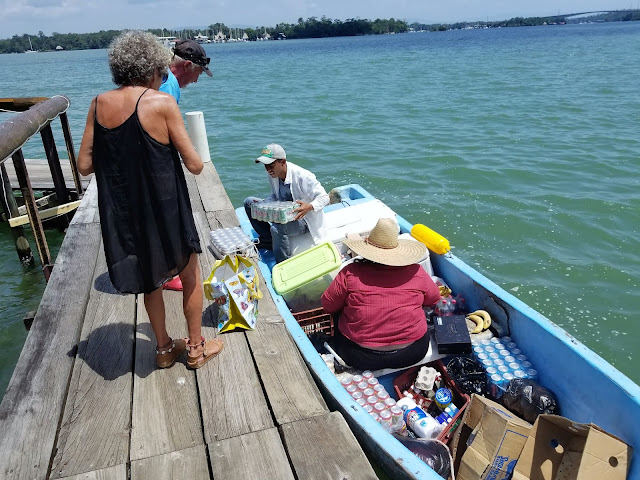FRONTERAS, GUATEMALA 5/15 - 5/22/2018
I arrived in Guatemala two weeks ago yesterday. Below are some photos and observations regarding the Catamaran Hotel and Marina, which is where Starship is, as well as of Fronteras, Guatemala, the nearest town.
Other stuff:
1. Despite the cruisers that come here for hurricane season, this really isn't a tourist area at all. So it's a pretty cheap place to live and there are quite a few expats. I think a person could easily eat out and drink on $15/day. This area also provides good access to many of the places there are to see in Guatemala and Honduras.
2. It's really been interesting spending more time with hard core cruisers. They're mostly couples and I would say the average cruiser is in their mid to late 50's. Some have been cruising for 30 years and there are a few just getting started, but I would say on average they've been doing it around five years. They almost all know each other and many will cruise together for long periods of time, go there own ways and then meet up again. They have great stories and are very helpful.
3. Once cruisers get to this corner of the Caribbean, they've usually done the eastern side already, so are either going back to the States or through the Panama Canal. For the most part, it sounds like they like the costs and the people here in the western Caribbean better.
4. Because of the low cost of experienced labor, this is a great place to have boat work done and almost every boat is doing something. I've had/am having, the entire exterior of the boat cleaned and waxed; the teak toe rails refinished; the stainless steel cleaned; and tarps made that will protect it from the sun and keep it cooler when at a dock or anchor for longer periods of time
5. For most of the past week, the temperatures have been pushing 100, with humidity in the 90's too. It's been brutal.
Other stuff:
1. Despite the cruisers that come here for hurricane season, this really isn't a tourist area at all. So it's a pretty cheap place to live and there are quite a few expats. I think a person could easily eat out and drink on $15/day. This area also provides good access to many of the places there are to see in Guatemala and Honduras.
2. It's really been interesting spending more time with hard core cruisers. They're mostly couples and I would say the average cruiser is in their mid to late 50's. Some have been cruising for 30 years and there are a few just getting started, but I would say on average they've been doing it around five years. They almost all know each other and many will cruise together for long periods of time, go there own ways and then meet up again. They have great stories and are very helpful.
3. Once cruisers get to this corner of the Caribbean, they've usually done the eastern side already, so are either going back to the States or through the Panama Canal. For the most part, it sounds like they like the costs and the people here in the western Caribbean better.
4. Because of the low cost of experienced labor, this is a great place to have boat work done and almost every boat is doing something. I've had/am having, the entire exterior of the boat cleaned and waxed; the teak toe rails refinished; the stainless steel cleaned; and tarps made that will protect it from the sun and keep it cooler when at a dock or anchor for longer periods of time
5. For most of the past week, the temperatures have been pushing 100, with humidity in the 90's too. It's been brutal.
 |
| Just one of the outdoor eating areas. Gives you an idea how nice the grounds are. |
 |
| Brian with Xcel Energy sent this basket down with Nita. So to advance Xcel's outreach to Central America, I gave it to Marvin. He thought it was pretty cool. |
 |
| From my dock I can see this boat house being built. Pretty interesting. |
 |
| Another dugout. |
 |
| Quite a contrast, nice ski boats and only a few hundred yards away, locals using dugout canoes as there only transportation.. |
 |
| This is the only bridge that crosses the Rio Dulce. It is very heavily used by tractor trailers, who all seem to jake break. Very loud and hard on the bridge.. |
 |
| One of the many unique vessels here. And like everywhere we've been, there are a lot of boats that will never sail again. |
 |
| When going to town, most all of the cruisers tie up at Bruno's dock. Bruno's is one of handful of good bars/restaurants that really cater to cruisers. |
 |
| This is Bruno's the Sunday before last, when they hosted a swap meet for cruisers. I was warned not to post any photos, since I guess there are some people down here who don't want to be found. |
 |
| A few of the hundreds of tractor trailers that use this bridge every day. |
 |
| It's mostly agricultural related goods being hauled through town, from cattle to ranch supplies to crops to timber. |
 |
| Narrow, well stocked aisles. |
 |
| At the check out line. This is on the border of cattle country, so there are a lot of cowboy hats, but not so many boots.. |
 |
| I have not developed an appetite for any of this. |
 |
| There's good access to locally grown fruits and vegetables. |





















Comments
Post a Comment